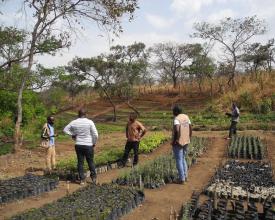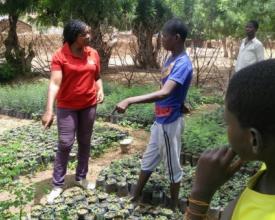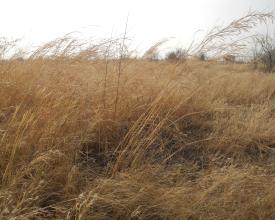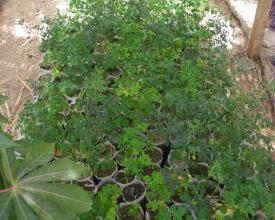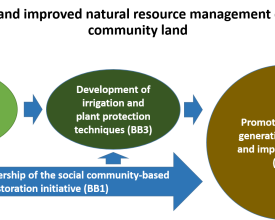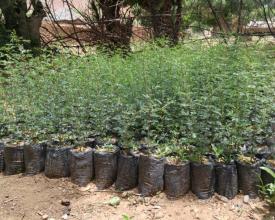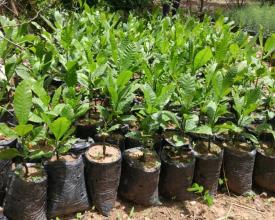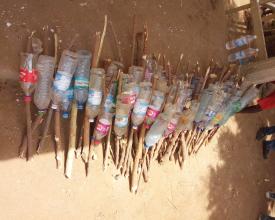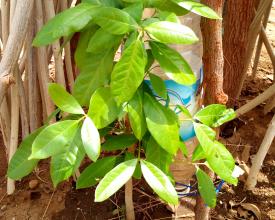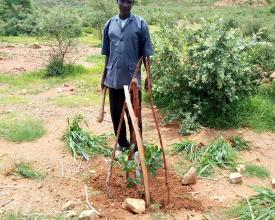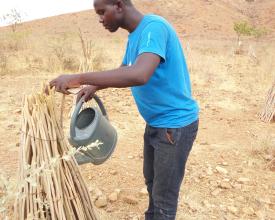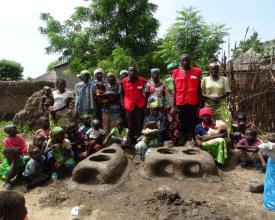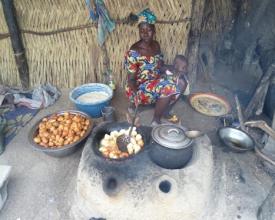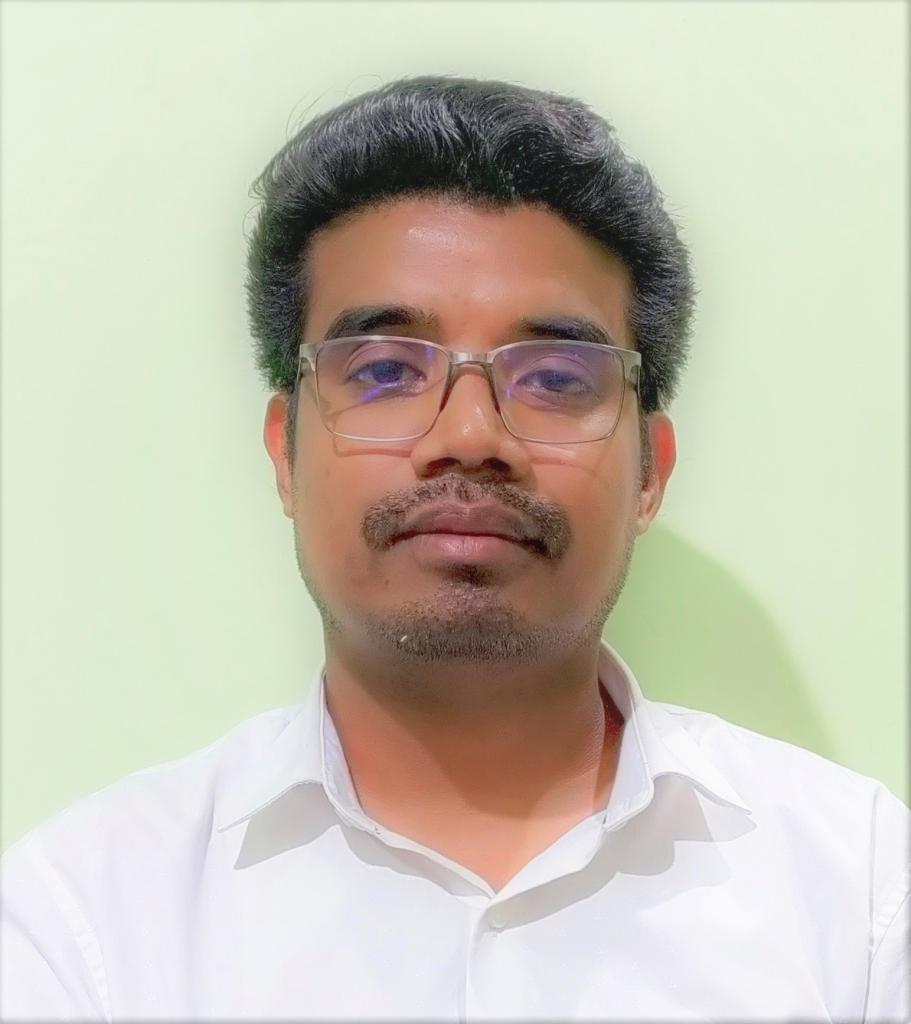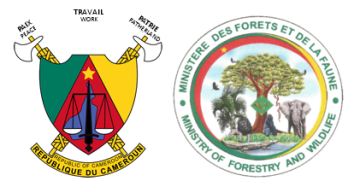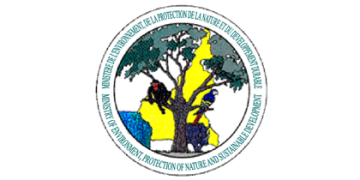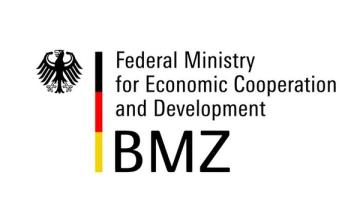
Forest Landscape Restoration and improved natural resource management of the Mogazang Community
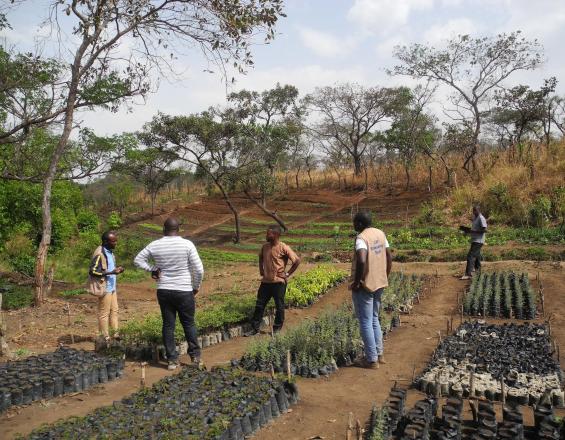
Desertification and its consequences threaten the well-being of the population in the northern part of Cameroon, especially rural households. The lack of fire and construction wood, and extreme poverty are major challenges for the population of Mogazang. Climate hazards such as shifting precipitation patterns are exacerbating risks for people. The elaboration of a map by the community members allowed the demarcation of a plot of degraded land (10.74 ha) for restoration. Adopting a "learning by doing" approach, different techniques to restore soil fertility were tested. While waiting for the plot to be productive, women received training in alternative income generating activities and the construction of improved cookstoves. The initiative thus contributes to AFR100 objectives through the restoration of degraded land, the reduction of the pressure on remaining natural resources and the generation of income.
Context
Challenges addressed
Despite an agreement by all involved stakeholders, keeping away stray cattle and sheep from the restoration plot has proved to be very difficult. Another plot within the community area was therefore demarcated to solely grow fodder for the animals. The plot was protected using woven stems of morning glory (Ipomea carnea) and neem tree (Azadirachta indica) poles.
The low rainfall in 2017 caused a large number of plants to dry up. This triggered a new initiative for irrigating the plants with drip irrigation, leading to the recovery of more than 50% of the wilted plants.
One of the major challenges is mobilising the community to become more involved in following-up on the project activities. We have therefore put in practice a social community-based approach where the engagement of all community members and the exchange between them foster the following-up on the restoration efforts.
Location
Process
Summary of the process
Promoting ownership of the restoration initiative and the participation of all community members from all social classes (BB1) was the pre-condition to start project implementation activities. This ensured the interest and participation of community members in the micro-zoning of the selected plot according to the soil type, the topography and the identification of adapted local tree species (BB2). Micro-zoning has facilitated the implementation of useful reforestation, with a range of specific techniques to protect and water the trees. The planned plant nursery situated in the village with a permanent water borehole will play a pivotal role for the entire initiative, especially the water borehole as it will provide water for multiple purposes (BB3). While waiting for the plot to be productive in terms of timber and other services, the women received training on the construction of improved stoves, aimed at reducing the consumption of firewood. Moreover, further income generating activities were promoted like the collection and transformation of non-timber forest products (NTFPs) (BB4).
Building Blocks
Promoting ownership of the social community-based restoration initiative and the participation of all social classes
An initial meeting between the traditional and religious authorities of Mogazang was held to gather all useful information and raise awareness among the population. As a next step, a socio-economic study was carried out in order to understand the potential social, economic and environmental impacts and challenges of the restoration initiative. The elaboration of a map by the community members under the guidance of the advisory team allowed the demarcation of a plot of degraded land (10.74 ha) for restoration. The reforestation initiative aimed at providing firewood, fodder, food products and medicinal plants, among others. The government owns the selected plot, under the supervision of the Executive Bureau for Development of the village. However, it is managed ‘by the people, for the people’.
Enabling factors
- Always ensure that the population’s concerns are well understood and that the proposed solutions will indeed contribute to solve their problem
- Involve representatives of all member groups of the society (particularly women and children)
- Ensure that there is no conflict of interest or disputed land rights regarding the project site
- Select qualified local people with sufficient education to write short activity reports and foresee their technical and managerial capacity building
Lesson learned
- Given the habits and customs of the Muslim community in the area where the initiative is implemented, it was challenging to actively involve women in the discussions.
- Subsequently, we were able to demonstrate the benefits of incorporating the women’s perspective in the discussions and thus achieved their better integration. Indeed, women are those who, on a daily basis, travel long distances in search of firewood justifying the need to involve them in the activities of the initiative.
- To achieve the feeling of ownership among the beneficiaries it is necessary to have administrative and traditional authorities to mobilise them.These authorities, however, tend to emphasize the monetary aspect, which can reduce the achievement of the objectives.
Micro-zoning of the selected plot according to the soil type, the topography and the identification of adapted local plant and tree species
Community members and experts developed a topographic map of the selected plot showing the different soil types and adapted local plant and tree species. Two main soil types have been identified:
- The soils of the mountainsides: stony surfaces; horizon 1 (0 to 20 cm) is silty sandy with a mixture of stony grains; horizon 2 (20 to 40 cm) is dominated by large stones and a small proportion of soil and horizon 3: (40 to more) was not accessible. For this soil type, the appropriate species are: Acacia (Acacia nilotica, Acacia Sieberiana, Acacia seyal), Neem Azadirachta indica, Anogeissus leiocarpus, Jujube (Ziziphus mauritiana), River Red Gum (Eucalyptus camaldulensis).
- The site bed is dominated by vertisols (i.e. soils with a high content of expansive clay minerals) with local withdrawal slots: horizon 1 (0 to 40 cm) composed of silt and clay and horizon 2 (40 to more) a mixture of silt, clay and stony grains. Suitable species include: Khaya (Khaya senegalensis), Cassia (Cassia siamea), African black plum (Vitex doniana), River Red Gum (Eucalyptus camadulensis), Winter thorn (Faidherbia albida), Cashew (Anacardium occidentale) and other fruit trees.
Depending on these different soil types, a mini-zoning allowed to delimit 11 blocks occupied by eight selected species.
Enabling factors
- Full involvement of the designated local facilitators who are willing to follow-up on the activities on a daily basis
- Participatory selection of the plant and tree species to guarantee a useful reforestation
- Adoption of the micro-zoning approach
Lesson learned
It is pivotal to take into account the physical characteristics of the plot for the success of the initiative including soil characteristics and topography by involving local experts. This allows to identify solutions for restoration that are sustainable and profitable in the short, medium and long term.
Development of specific techniques to protect and irrigate the plants
The community tested various techniques to fend off stray livestock following the planting period. These included protecting the area with a dead hedge made of thorny branches, with pink morning glory (Ipomea carnea) woven rods supported by poles and with iron wire from the carbonization of worn car wheels. These efforts were, however, without much success. In addition, following the long dry season and the low rainfall in the region in 2017, the community’s water source dried up and the plants withered. The idea of collecting water with empty cans at the community’s water borehole (~ 3 km) was not feasible due to the lack of financial resources.
However, another system through drip irrigation devices made of used bottles collected in the city was also used. Drip irrigation devices were attached to the foot of seedling. The water was then drawn from barrels and stored on site. This system permitted the seedlings to be watered three times a week allowing nearly 40% of the wilted plants to grow again. The construction of a permanent plant nursery with an onsite water borehole has been as well finalised.
Enabling factors
- Capacity building of the local facilitators in the ‘learning by doing’ method to develop restoration techniques allowed the production of 2600 plants in 2017
-
Ability to develop one-off actions that can be improved depending on the situation.
-
Individual plant protection approach. e.g. use of a mat to protect the plants (see pictures)
- Use of a drip irrigation system with reused water bottles
- Promotion of the separate production of livestock fodder
Lesson learned
- Difficulty to access water, which is primordial for the growth of fruit trees that require irrigation during the long dry season. Of the 4022 seedlings planted, 2162 are alive and 1860 dead on eleven blocks containing eight fruit and forest species in August 2017
- The benefits of constructing a village plant nursery with an onsite water borehole (permanent production of quality plants, livestock watering, human consumption and therefore reduction of waterborne diseases, which causes the high infant mortality rate in the community)
- The possibility of dividing the plot into sub-plots of approximately 500 m2, which will be gradually restored (year 1, year n+1, year n+2, ..., year n+5), in order to make it more secure
Promotion of income-generating activities and of improved stoves
The lack of fire and construction wood is a major challenge for the beneficiaries of the initiative. Therefore, we put into practice a holistic and inclusive approach:
- Strengthening the beneficiaries’ capacities for setting up and managing a social community space, taking into account the necessary resources
- The collection and processing of NTFPs from the restored plot, such as Neem seeds for oil production (income-generating activities)
- Gender mainstreaming: construction of improved stoves that is carried out by two Trainers Coordinators: Woman/Man who supervises the activities, who will in turn train Relay Trainers in the target villages in construction, awareness and means of popularization of improved stoves and aware of the problem of wood energy. TwoTypes of improved stoves were used: "foyers améliorés 3 pierres", "foyers améliorés Bill-Bill". They increased their source of income, reduced the use of firewoods.
- While the recently planted trees and plants are still growing, 35 women have received training to build improved stoves using clay and straw which are raw materials found in nature (zero cost). This improves the living conditions of the population and reduces the pressure on the remaining natural resources.
Enabling factors
- Effective participation of women
- Availability of the raw material (clay and straw)
Lesson learned
Two women form a neighbouring village (Doualaré), who themselves were trained by GIZ Wood-Energy Experts, trained the women of the project site regarding the construction and use of improved stoves. This kind of ‘farmer-to-farmer training’ empowers women and disseminates the techniques.
Impacts
Environmental:
- Planting of nearly 10,000 plants, coupled with the construction of water retention bunds, in eleven blocks comprising eight fruit (e.g. mango, cashew) and tree species (acacia).
- Protection of the site against stray cattle and designation of an area solely to grow fodder
- Use of the agave sisal (Agave sisalana) to prevent water erosion, especially downstream of the water catchment area
- Improvement of the microclimate and stabilization of erosion in order to contribute to the improvement of soil fertility through the plantation of plant and tree species
- Natural assisted regeneration with Guiera (Guiera senegalensis) stems, which have continued to grow thanks to the opening of firebreaks upstream of the water catchment area
Socio-economic:
- The local population applies the acquired capacities in compost production
- Women constructed improved stoves and are using them
- Strengthening of the managerial and technical capacities of nineteen village leaders
- High-value species (neem, cashew nut, moringa) have been planted on the restoration plot for future income generation
- Involvement of women at all stages of the different value chains such as timber, edible fruits and other non-timber forest products (NTFPs)
Beneficiaries
- Mogazang community and the sourrounding villages (Gayak, Kossewa and Dogba)
- Traditional authorities
- Decentralized territorial authorities
- Community Interest Groups (GICs)
- Ministry of the Environment and Nature Protection
- Ministry of Forests and Wildlife
Sustainable Development Goals
Story
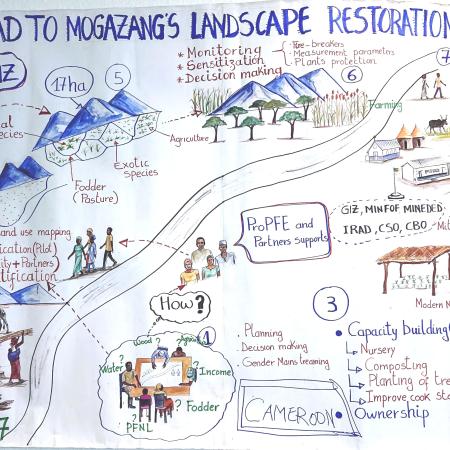
"The implementation of this restoration initiative allowed identifying difficulties of the beneficiaries with the participative and inclusive social community-based approach. Several social, ecological and institutional constraints hindered the progress. However, every time, possible solutions were proposed, discussed and validated in a consensual way. The combined use of traditional local knowledge and technical expertise ensures that the expected results will commensurate with the human, financial and material resources invested. A minimum of five years consecutive follow-up after planting aims at the development of a territorial management model to be replicated in other communities, taking into account management and technical capacity building as main enabling factor for this kind of initiative. This scaling-up allows improving the livelihoods of the rural population, which is part of national and international commitments of the Cameroonian government." Makueti Josephine Therese, technical advisor in Forestry, Deutsche Gesellschaft für Internationale Zusammenarbeit (GIZ) Cameroon.
